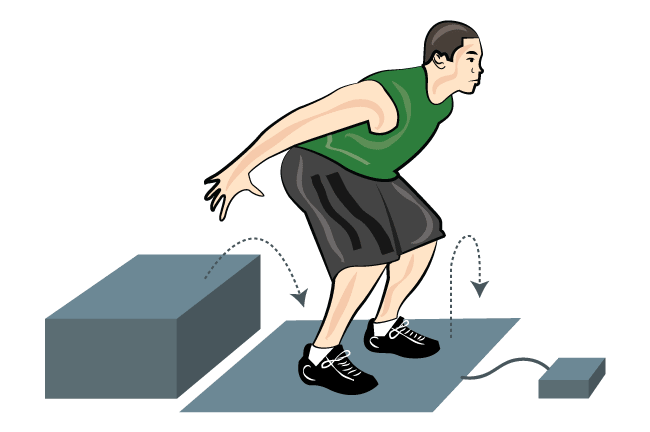This procedure describes the method used for measuring reactive leg strength using the Drop Jump, where the athlete jumps after a drop from a series of heights, starting from a 30cm box and working upwards to a 75cm box. There is also a drop jump test as part of the Bosco Ergo Jump System. See about other vertical jump tests.
purpose: to measure the reactive strength index of the lower limbs
equipment required: vertical jump measurement mat (e.g. just jump mat, Myotest, infrared laser system), boxes or elevated platforms of different heights, e.g. 30 cm, 45 cm, 60 cm, 75 cm.
pre-test: Explain the test procedures to the subject. Perform screening of health risks and obtain informed consent. Prepare forms and record basic information such as age, height, body weight, gender, test conditions. Check and calibrate the timing mat measurement. Subject to perform an appropriate warm-up. See more details of pre-test procedures.

procedure: A drop jump is performed from a range of box heights (30 cm, 45 cm, 60 cm, 75 cm), starting from the lowest height. The athlete stands on the box adjacent to the timing mat. Hands are placed on the hips, and stay there throughout the jump. The athlete steps down off the box onto the mat, bending the knees on landing, then immediately going into a maximal vertical jump. The athlete jumps vertically as high as possible, and lands back on the mat with both feet landing at the same time. The test is repeated for increasing box heights, for example using 30 cm, 45 cm, 60 cm, 75 cm boxes. Allow an adequate rest between trials.
scoring: Reactive strength index (RSI) can be calculated by diving the jump height by the ground contact time. The jump height time is the time between the participant's feet leaving the timing mat or force platform and when they contacted it again. The vertical jump height in meters can be calculated from the time (in seconds) using this formula: jump height = 4.9 x (0.5 x Time)2. Ground contact time is the time between the first foot contact with the force platform and when the participant's feet left the mat.
results: If an athlete jumped 36cm with a contact time of 0.18secs then they would have an RSI of 200. The athlete can therefore improve their RSI by increasing the height of their jump, by decreasing their ground contact time, or both of these.
disadvantages: drop jumps require athletes to have a good degree of leg strength, as the forces through the body is much higher than for a standard vertical jump test. The standard size boxes are not readily available, and may even need to be custom made.
comments: Though this is the standard test of reactive strength, there are also other methods to assess an athlete's reactive strength ability. See more about the Reactive Strength Index.
Similar Tests
- Drop Jump — a test of leg strength and power which requires the athlete to drop off a box and immediately jump as high as they can
- Drop Jump (Bosco) — the athlete jumps after dropping from heights of 20 cm, 40 cm, 60 cm, 80 cm and 100 cm.
- Force Plate Vertical Jump
- Vertical jump using a timing mat
- No arms vertical jump
Related Pages
- Reactive Strength Index — the ratio between the height jumped and the ground contact time.
- A discussion about the various vertical jump equipment available
- A discussion about other vertical jump techniques
- See the list of anaerobic tests for other fitness tests of leg power.
- About force plates and force platforms


 Current Events
Current Events